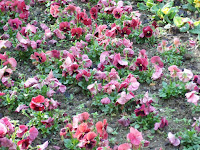 A winter nosegay: a handful of bright red anemones, the dense, white waxen buds of viburnum, a single rose shaded vanilla ice cream, glossy, lanceolate, deep green leaves, small, orange rose berries and a simple raffia ribbon around the bare stems.
A winter nosegay: a handful of bright red anemones, the dense, white waxen buds of viburnum, a single rose shaded vanilla ice cream, glossy, lanceolate, deep green leaves, small, orange rose berries and a simple raffia ribbon around the bare stems.It was a present. I received it at “Orticoline d'inverno”, the market flower show held at the beginning of December, in Milan, Italy. This is the second winter edition, but my first visit, while I am a loyal visitor of the most famous exhibition that occurs in May in Via Palestro, always-in Milan. I made a wise “sortie” reaching, soon after lunch, the Museo Diocesano, where the show was located. Opened in 2001, this museum collects ancient and precious works of art of sacred inspiration and liturgical use from the parishes of the surrounding area.
The show developed in two large rooms at either sides of the entrance, after an aisle I hastily crossed. Art and flowers welcomed the visitors i
 n a warm environment, with the characteristic perfume of plants, the red of Christmas and the hum of voices. On display were rich collections of orchids, cyclamen and poinsettias, particular vegetal worlds that attract a numerous public eager for answers and newness. All the others, included me, looked at them with curious and amazed glances, merely enjoying the variety of colours and shapes, in a complete ignorance of names, places of origin and cultivation requirements. I lingered longer in the other room, before the shelves covered with moss, embroidered with ferns and hidden under expensive hellebores. A triumph of red and violet berries, especially skimmia and gaultheria, surrounded them so that you hardly realized the gigantic paintings on the wall behind. The delicate flowers of the winter camellias were scattered in the room. Exotic flowers deserved a picture, a thought and the promise to see the banksie and the airy tillandsie in their natural world, during the incoming year. Old style garden furniture inspired large country mansions covered with abundant snowfalls and crowded with children and dogs. It turned out that the stone fountain plate, with a small bird craved on the edge, is a successful centerpiece for the tables in Milan. Tea and pastries were expected for five o’clock in the afternoon.
n a warm environment, with the characteristic perfume of plants, the red of Christmas and the hum of voices. On display were rich collections of orchids, cyclamen and poinsettias, particular vegetal worlds that attract a numerous public eager for answers and newness. All the others, included me, looked at them with curious and amazed glances, merely enjoying the variety of colours and shapes, in a complete ignorance of names, places of origin and cultivation requirements. I lingered longer in the other room, before the shelves covered with moss, embroidered with ferns and hidden under expensive hellebores. A triumph of red and violet berries, especially skimmia and gaultheria, surrounded them so that you hardly realized the gigantic paintings on the wall behind. The delicate flowers of the winter camellias were scattered in the room. Exotic flowers deserved a picture, a thought and the promise to see the banksie and the airy tillandsie in their natural world, during the incoming year. Old style garden furniture inspired large country mansions covered with abundant snowfalls and crowded with children and dogs. It turned out that the stone fountain plate, with a small bird craved on the edge, is a successful centerpiece for the tables in Milan. Tea and pastries were expected for five o’clock in the afternoon. At the entrance, a patient team composed bunches of flowers upon request.They fished the needed material from blue buckets. Flowers had reached Milan from the conservatories in San Remo, a town by the Mediterranean Sea.
This charming nosegay reminds me of another winter bunch. It was described in an article written by Mrs. Vita Sackville-West for the column she wrote for the “Observer” from 1946 to 1961. Later, many of these articles were collected in a lovely book “In Your Garden”. In her simple but careful style she presented the plants and places she knew, an everyday garden life she deeply loved and lived.
February 26, 1950
A dear near neighbour brought me a tussie-mussie this week. […] a nosegay […] It is composed of at least five different flowers, all perfectly chosen. She goes always for the best, which I am sure is the secret of good gardening: choose always the best of any variety you want to grow. Thus, in the bunch she brought me, the violet were pink violets, the sort called Coeur d’Alsace, and Iris Reticulata she put in was the sort called Hercules, which is redder than the familiar purple and gold. […] The anemone that she put in must be a freakishly early bloom of Anemone St. Bavo, amethyst petals with an electric-blue centre. (Sackville-West, 2004; 35)

I am not sure about the specie of these anemones, but […] a flowerless room is a soul-less room. (Sackville-West, 2004; 150)
I really love to see my winter nosegay in bloom on a table against a window that frames the first whirls of snow.
Flower show:
ORTICOLINE D’INVERNO - MUSEO DIOCESANO C.so di Porta Ticinese, 95 - MILANO
http://www.orticola.org/mostra.htm
Further readings:
In Your Garden – V. Sackville-West, First Frances Lincoln Edition, 2004 from Books Google December 2009
http://books.google.it/books?q=in+your+garden









































